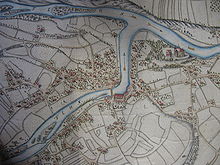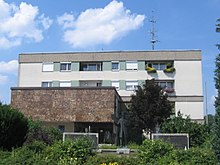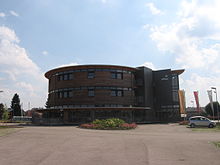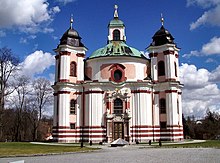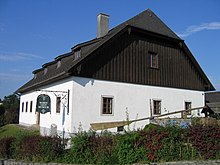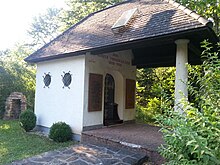Stadl-Paura
|
market community Stadl-Paura
|
||
|---|---|---|
| coat of arms | Austria map | |
|
|
||
| Basic data | ||
| Country: | Austria | |
| State : | Upper Austria | |
| Political District : | Catfish Land | |
| License plate : | WL | |
| Main town : | Stadl-Traun | |
| Surface: | 15.02 km² | |
| Coordinates : | 48 ° 5 ' N , 13 ° 52' E | |
| Height : | 360 m above sea level A. | |
| Residents : | 4,987 (January 1, 2020) | |
| Postal code : | 4651 | |
| Area code : | 07245 | |
| Community code : | 4 18 20 | |
| NUTS region | AT312 | |
| Address of the municipal administration: |
Marktplatz 1 4651 Stadl-Paura |
|
| Website: | ||
| politics | ||
| Mayor : | Christian Popp ( FPÖ ) | |
|
Municipal Council : (2015) (31 members) |
||
| Location of Stadl-Paura in the Wels-Land district | ||
| Source: Municipal data from Statistics Austria | ||
Stadl-Paura is a market town in Upper Austria in the Wels-Land district with 4987 inhabitants (as of January 1, 2020). Historically, half of the community is located in the Hausruckviertel and the Traunviertel . Today it is counted with the entire district of Wels-Land to the Hausruckviertel.
geography
Geographical location
Stadl-Paura is located at an altitude of 360 m in the Hausruck and Traun districts at the confluence of the Ager and the Traun . The community belonged to the judicial district of Lambach until 2012 and has been part of the judicial district of Wels since January 1, 2013 . The extension is 6.5 km from north to south and 5.2 km from west to east. The total area is 15.05 km². 67.3% of the area is forested, 16.7% of the area is used for agriculture and the remaining 16% is used for other purposes.
Neighboring communities
The neighboring communities of Stadl-Paura are Lambach in the north, Edt bei Lambach in the northeast, Bad Wimsbach-Neydharting in the southeast, Roitham am Traunfall in the south, Rüstorf in the southwest and Neukirchen bei Lambach in the northwest.
| Neukirchen | Lambach | Edt |

|
||
| Riistorf | Roitham am Traunfall | Bad Wimsbach-Neydharting |
Community structure
The municipality includes the following three localities (population in brackets as of January 1, 2020):
- Stadl-Hausruck (1214)
- Stadl-Traun (3652)
- Stadl-Ufer (121)
The community consists of the two cadastral communities :
- Stadl-Paura - Hausruck
- Stadl-Paura - Traun.
Demographics
| year | Pop. | Change% |
|---|---|---|
| 1869 | 2,625 | --- |
| 1880 | 2,421 | −7.8 |
| 1890 | 2,601 | +7.4 |
| 1900 | 2,672 | +2.7 |
| 1910 | 2,840 | +6.3 |
| 1923 | 2,905 | +2.3 |
| 1934 | 3,155 | +8.6 |
| 1939 | 2,976 | −5.7 |
| 1951 | 6.093 | +104.7 |
| 1961 | 4,691 | −23.0 |
| 1971 | 4,841 | +3.2 |
| 1981 | 4,744 | −2.0 |
| 1991 | 4,838 | +2.0 |
| 2001 | 4,866 | +0.6 |
| 2011 | 4,931 | +1.3 |
| 2014 | 4,903 | −0.6 |
- citizenship
- 88.2% of Stadlingers are Austrian citizens, 0.9% come from the EU-15 and the remaining 10.9% are from third countries.
- religion
- With 70%, the majority of the citizens profess to the Roman Catholic Church, 6.9% are Protestant, 4.1% Orthodox, 5.8% Islamic and 11.0% are without religious belief. The remaining 2.2% relate to other or unknown confessions.
- marital status
- Almost half of the people of Stadling are married (45.4%) and about the same percentage are single (40.8%). There are also 7.8% widowed and 6.0% divorced.
- households
- The municipal area comprises 2,019 households, with the average household housing 2.4 people.
- Statistically speaking, the 1,398 families in Stadl-Paura each have one child.
coat of arms
Blazon of the municipal coat of arms awarded in 1969:
- "In blue with a silver double corrugated strip in the base of the shield, crossed diagonally, a golden boatman's hook and a golden oar, above a golden disc, covered with a golden triangle surrounded by rays."
The community colors are: blue-yellow-blue.
The two silver waves represent the two rivers Traun and Ager, on which Stadl-Paura lies. The golden boat's hook and the golden oar stand for the ship's tradition deeply rooted in the village. The golden triangle is a symbol for the Trinity Church, the Paurakirche.
history
Stadl until the 13th century
When salt deposits were probably found in Hallstatt as early as the Neolithic Age and the trade in white gold began, the first settlement took place in Stadl on the Paurahügel. The people who lived there had settled down on the hill mainly because of the surveillance of the waterway. Transport routes were required to transport the salt, for which the Traun was ideally suited. Only after crossing the Traunsee presented an insurmountable obstacle for the time, the Traunfall . The salt had to be reloaded at this point and brought by horse-drawn wagon or similar to an area where the Traun was navigable again and where there was enough space for it. The area of today's Stadl turned out to be ideal for these activities. So there was a pre-Christian salt storage area and a reloading point in Stadl. Excavations on the Paurahügel show that it was not just a simple farming settlement, but a fortified base.
Since Stadl had a natural harbor at that time, a real industry was built up. The main feature was probably the "Salzstadeln" which gave the place the first part of its name, the second part was added later with the construction of the Paurakirche . Originally there were 16 barns, first mentioned in 1298, until the great fire in 1831 destroyed all of them. Since the salt shipping industry was slowly coming to an end at that time, only four barns were built. The old ship stalls stood on the Traun until 1916. At the site of today's horse center there were stables for over 200 horses that pulled the salt barges up the river. Stadl was also the stop of the k. & k. privileged horse-drawn railway .
Numerous finds suggest that there were three ways from the Traunsee to Stadl. The first led west of the Traun from Altmünster via Pinsdorf to Ohlsdorf and finally via Aichlham . The second route followed roughly the course of today's Gmundener Straße B 144 from Gmunden via Laakirchen and Roitham am Traunfall to Stadl. Finally, the third way bypassed the Traunfall on a large scale and led over the Laudach - and the Almtal .
At the beginning of the Bronze Age , a palisade trench was dug in the south of the Paura hill to supplement the protection provided by the wild rivers (Traun and Ager) in the north and west.
The facilities were also preserved in Roman times and the Roman road that led to Lambach made the area around Stadl even more important as a salt handling point.
During the Great Migration , many foreign peoples moved along the Roman roads and robbed and plundered, with the result that the Paura hill was probably given the function of a kind of refuge .
In the 13th century the settlement on the Paura hill was dissolved. The reasons for this are still unclear.
The era of salt shipping
In 1311, the Hallstatt salt mining was reorganized by Queen Elisabeth, which resulted in an increase in trade on the Traun. As a result, the major obstacles to shipping were removed, including the Traunfall, which was expanded for the first time. In 1552 the famous hydraulic engineer Thomas Seeauer built the 400 m long wooden canal at the Traunfall.
Another problem for the salt boaters was that the Traun from Stadl flowed in a wide bed and divided into many side arms. In addition, the loose gravel soil of the Welser Heide meant that the Traun was constantly changing. These are further reasons for the favorable development of Stadl, because the ships could no longer immerse so deeply, which made reloading to many smaller ships necessary. For example, the amount of salt from 60 “Trauners” (the ships that went from Gmunden to Stadl) had to be reloaded onto 110 salt barges.
The Stadlinger Schiffer brought the salt barges to the confluence of the Traun in the Danube near Zizlau . At that time Zizlau was a suburb of Linz and was leveled by the National Socialists in order to build the Hermann-Göring-Werke (today's VOEST ) on it.
The decline of salt shipping began with the opening of the first horse-drawn railway and the steam railway that followed. The era of the salt boaters ended in the 20th century when the last salt barge sailed the Traun on November 4, 1911.
Shipbuilding tradition in Stadl
In the heyday of salt shipping, there were 170 shipbuilding sites on the rivers and lakes of the Salzkammergut , which built ships for the transport of salt, but also for the imperial army. Of the numerous shipbuilding sites on the Traun, also known as Schopperplatz, four of them were in Stadl. Back then, as now, building a ship took the necessary experience and a lot of time. First you had to bring the necessary trunks from the Attersee area to Stadl. These 30 to 35 meter long spruce trunks were then wound up and sawn apart in the middle with a "three-man saw". Later the boards for the ship's bottom and the ship's walls were sawn from it. The wall boards were beveled on the side so that a V-shaped groove formed when they were put together. This groove was "topped" with moss, hence the name Schopper, and covered with a wooden plate. At the end the whole thing was stapled with a guitar. This construction had to be in the water for a few days to solidify and to seal the ship.
To stabilize the ship, so-called tilts were used as the ship's ribs. These butts consisted of the root wood of young trees and also had to have grown at right angles. Because of the great demand for salt ships, entire forests were destroyed at that time. To put a stop to this, counter trains were introduced on the Traun from 1511.
Nothing remains of the shipbuilding sites in Stadl-Paura today, only street names are reminiscent of the very important craft from the era of salt shipping.
The plague in Stadl-Paura
The year 1713 was the height of the plague in Upper Austria . At that time Maximilian Pagl , who was born in Stadling, was the abbot of Lambach Abbey . Worried about the threat of the plague , he made a vow to build a church in honor of the Holy Trinity if Lambach and the surrounding area were spared the plague. The following winter brought the epidemic to a standstill. In Stadl there is still a small memorial for this occasion, the plague column. Maximilian had a much larger monument erected on the Paura hill, the Paurakirche. Already at the beginning of 1714 he applied for the building permit for a Holy Trinity Church on the Paurahügel, which he received a little later. The basic idea was to represent the Trinity of God, so the number “3” is predominant in the design. The church has three gates, three main windows, three altars, three organs and three corner towers.
The master builder Johann Michael Prunner from Linz was hired for the architectural implementation . No expense or effort was spared to let the new magnificent building shine in full splendor. Contemporary artists such as Martino Altomonte , Carlo Carlone , Parodio and Messenta were responsible for the interior design.
After ten years of construction, the Paurakirche was completed in 1724. On July 29, 1725, the inauguration by the Passau prince-bishop Count von Lamberg followed .
French Wars
In the center of Paris , a column on the Place Vendôme still reminds us of the campaign of Napoleon I in 1805. All the prominent war events are depicted on it, including a picture of Lambach , Stadl-Paura and the Traun.
In Stadl-Paura itself, a cannon ball walled into a house and the so-called French chapel reminds of this time.
Second World War
A children's home founded in Stadl-Paura in 1911, in which religious sisters of the “ Seraphic Love Work ” looked after orphans and children with disabilities, was closed in September 1940 by the National Socialists. Dozens of children were brought to the Niedernhart sanatorium in Linz . It is possible that they later became victims of the Nazi “euthanasia” campaign “T4” in Hartheim . There is evidence that three boys died in Niedernhart in the spring of 1941.
politics
Mayor after 1945
- August Lehr 1945–1946
- Anton Engljahringer (SPÖ) 1946–1955
- Josef Habel (SPÖ) 1955–1983
- Harald Spitzbart (SPÖ) 1983–1984
- Albert Schneider (SPÖ) 1984–1994
- Gerhard Ernst (SPÖ) 1995–1996
- Alfred Meisinger (SPÖ) 1996-2015
- Christian Popp (FPÖ) since 2015
elections
Municipal council election 2015
Election result of September 27, 2015 with 3,798 eligible voters and a voter turnout of 74.51%.
- ÖVP, Austrian People's Party 13.35%
- SPÖ, Social Democratic Party of Austria 36.14%
- FPÖ, Freedom Party of Austria 43.56%
- LR, Stadl-Paura habitat 6.95%
Mayoral election 2015
Result of the runoff election on October 11, 2015 with 3,798 eligible voters and a voter turnout of 70.17%.
- Christian Popp, FPÖ 59.01%
- Eva Hofer, SPÖ 40.99%
Community partnerships
Stadl-Paura has had a partnership with Krähenwinkel , a district of Langenhagen in Lower Saxony , since 1974 . The impetus came from long-term contacts between the two volunteer fire departments.
education
- Elementary school
- Founded in 1910 as the Kaiser Franz Joseph Jubilee School . Until the middle of the 20th century, the building was used, among other things, as a quarters for occupation soldiers and as an external camp school for refugees. In 1958 a class ceiling collapsed during the holidays. The school was then rebuilt and opened in 1962 as the Franz Keim School with a new gym.
- secondary schools
- Founded in 1920 as a private secondary school for girls in the Nazareth Monastery and run by the Order of the Sisters of St. Charles Borromeo . Due to a lack of young nurses, the private school was closed after the 1999/2000 school year and has since been run as a public secondary school for boys and girls. Two main subjects are offered: computer science and foreign languages.
- State music school
- Founded in 1951 as the Lambach / Stadl-Paura music school by both communities. Friedrich Kinzl was the director from the very beginning. Karl Schmidinger followed him. In 1977 the music school was taken over by the state of Upper Austria in cooperation. In 1998, Hubert Ecklbauer was appointed music school director by the state of Upper Austria. There are branches in Lambach and Steinerkirchen. In 2018, around 850 students were taught by 35 teachers across the entire school association.
- Federal Institute for Agricultural Biology
economy
- Linde Gas GmbH
- A subsidiary of the global gas company Linde AG . Founded in 1914 as the Lambach oxygen and hydrogen plant , the headquarters of the Austrian Linde Gas GmbH have been in Stadl-Paura since 1985 . There are also branches in Austria in Vienna , Graz , Linz , Eggendorf , Kapfenberg , Klagenfurt and Wörgl . The company produces all kinds of gases for commercial, industrial, medical and other applications.
- Lambacher Hitiag Leinen AG
- Founded in 1853 as “Lambacher Flax Spinning Corporation”, up to 1,000 people worked in shifts in the company at peak times. The company specializing in linen production was for some time the largest linen spinning mill in Europe. In line with the general trend, the Lambacher Hitiag Leinen AG has also consistently cut jobs. The dismantling resulted in the closure of the plant near Pöchlarn in 2001 and thus the relocation of wet yarn production to Tolna, Hungary . After the elimination of another 60 jobs, it was decided on January 25, 2005 to close down production in Stadl-Paura. The group headquarters, sales and warehouse will remain in Stadl-Paura with around ten employees.
- Mission Transport Working Group - MIVA
- The Austrian MIVA , based in the Christopherus House in Stadl-Paura, is an aid organization of the Catholic Church, which has set itself the goal of financing vehicles of all kinds for use in mission and development aid. The company was founded on October 22, 1949 in Lambach Abbey . MIVA vehicles are used in Africa, Latin America and Asia and enable priests and development workers to travel safely and reliably through the streets, which are often difficult to pass. Since it was founded, over 17,000 vehicles have been financed by the Austrian MIVA.
- Alaska Sport-Dress Wilhelm Stepek Gesellschaft mbH & Co. KG
- The Alaska company has been producing ski fashion at various locations for over 40 years and distributing it through its branches all over the world. The headquarters of this internationally active company was in Stadl-Paura until mid-2015. Other locations in Austria were Klagenfurt , Innsbruck , Passau , Vienna and Salzburg . The company was liquidated in May 2015 after going bankrupt.
- Cable TV Stadl-Paura Gesellschaft mbH
- Local provider of cable television, broadband internet and telephone, founded in April 1991.
Culture and sights
- The baroque pilgrimage church Stadl-Paura was built between 1714 and 1724 by the Upper Austrian master builder Johann Michael Prunner (1669–1739). The church is a votive building that was donated by the Lambach abbot Maximilian Pagl as a thank you for sparing the area from the plague. The patronage of the Trinity was consistently implemented in terms of building type, equipment, furnishings and choice of materials. The number “3” is decisive: a triangular floor plan, three towers, three altars, three marble portals, etc. High altar painting by Martino Altomonte and D. Parodi , third altar painting and dome painting by Carlo Carlone ; three organs by Johann Ignaz Egedacher .
- The Schiffleutmuseum is a museum of the Stadl-Paura Schifferverein and at the same time the birthplace of Abbot Maximilian Pagl . The museum deals with the history of Stadl-Paura as an important transshipment point for the salt from the Salzkammergut. For example, a replica of the Traunfall can be seen . The ship's museum is also home to the traditional costume group of the Stadlinger Schifferverein. With around 460 members and 50 people wearing traditional costumes, it is one of the most important associations in Stadl-Paura. The club even has its own march composed by Karl Schmidinger .
- Austrian Horse Center Stadl-Paura
- The former k. & k. Stallion depot was renamed the Austrian Horse Center after privatization. All sorts of horse events take place in this horse center every year.
- These include European and World Championships as well as smaller horse shows on the weekends. But the very popular Christmas market has also been a permanent fixture here for several years.
- In addition, there is also a breeding institute, a training and marketing center and a training and further education center for the Lambach agricultural college in the Stadl-Paura horse center.
- Army ammunition facility Stadl-Paura
- In 1938, after Austria was annexed to the German Reich , the German Air Force bought around 200 hectares of forest from Lambach Abbey. However, there were also properties in this area owned by private individuals who received no compensation for the sale of their forest.
- The construction of an air force facility began immediately. The factory produced grenades and bombs for years. Shortly before the end of the war, Ukrainian forced laborers from the flax spinning mill were even housed in the institution. When two of them tried to flee, they were handed over to the police without further ado and executed.
- After the war, the factory was shut down and many companies wanted to buy it for their projects, including Porsche AG, which wanted to build a car factory here.
- But the most bizarre project was that of the flax spinning mill. The then general director Ludwig Balder wanted to set up a hot water roaster and a flax rocking system on the site and transport the flax, which had been pre-processed in this way, to the actual site of the spinning mill using a cable car. Finally, the state of Austria bought the site and first housed the B-Gendarmerie and later the armed forces .
- On September 16, 1948, during the planned removal and subsequent destruction of residual ammunition, a momentous explosion occurred that claimed five lives. There were also three seriously injured and ten slightly injured.
- A fuse factory was later set up on the site. Another misfortune occurred while testing a wear machine. When handling two barrels filled with the explosive Boleron , an explosion occurred that cost two people their lives. The shock wave caused a warehouse and some window panes in the nearby housing estate were destroyed.
- Today the army ammunition facility is only used as an ammunition store for the Austrian Armed Forces and has been one of the last camps in Austria since the army was restructured.
- Evangelical Trinity Church
- Up until 1945 there were only a few Protestant families in Stadl-Paura. It was not until the Second World War that many expellees from Romania and the Balkans came to Stadl-Paura and the number of Protestant residents increased by leaps and bounds.
- At first there was only one preaching station in Stadl-Paura, run from Wels , which was housed in a barrack of the refugee camp. In 1960 the Wels parish bought a house in today's Kirchengasse and set up a prayer room there. In 1964, Stadl-Paura became a subsidiary of Wels and in 1970 an independent Evangelical Parish AB
- But the community still lacked a church. In 1973 an offer came from Aachen in the Rhineland to give the community a small church. In 1974 the dismantling took place in Aachen and on April 7th the foundation stone was laid in Stadl-Paura. The church was consecrated by Superintendent Temmel on the first Sunday in Advent of the same year.
- In 2005 the decision was made to install a solar system on the church roof in order to reduce the high costs for heating and hot water. The project was completed in 2006 and the Evangelical Parish received the EU's GreenBuilding logo in the same year .
- Former station building of the horse-drawn railway

- In 1834 the Lambach railway company bought a piece of land of about one yoke for 200 guilders in Stadl-Paura. Construction work began on August 1st of the same year and was completed in an astonishingly short time. The building housed apartments for the servants as well as a guest room and later 15 guest rooms. A large tower clock was also attached to the station at that time, and can now be seen in the Vienna Railway Museum. It bears the inscription “ Johann Holleder poured me in front of the directors of the KK priv. First EBGes. in Linz 1835. "
- Stadlinger Bahnhof has often been described as the largest and busiest on this route. Probably because of the train restaurant, which from today's perspective was the first of its kind. So you can say that Stadl-Paura owned the first train station hotel in Upper Austria . This inn or hotel was run by the innkeeper Keim, the father of the later famous poet Franz Keim . He saw the light of day here in 1840 and later wrote about this building in his works: "My parents had, through hard work and good economy, enlarged the then small inn and brought it to an honorable pile."
- Today the building serves as a residential building and as a youth center. Only the old stories and pictures from that time remind of the hustle and bustle at the train station.
- Nazareth Monastery
- The monastery was founded by Nazareth abbot of the pin Lambach Theodoric Hagn . On December 22nd, 1864 the monastery was inaugurated by the founder, Abbot Hagn. As early as January 1, 1865, the Borromean women began to look after the sick, old people, children and young people in Stadl-Paura. In 1904 the monastery was rebuilt to its present form. Later on, renovations and additions were made repeatedly and the number of religious sisters grew from originally 3 to 40.
- In 1919 the citizens' school for girls was opened, but on June 29, 2002 it was rededicated as the general secondary school for boys and girls.
- Of course, the monastery also housed an old people's home, which in the 1980s offered space for 50 people, some of them in need of care. In 2003 the groundbreaking ceremony for the new social center of St. Anna GmbH took place. The new building was opened in summer 2005 and equipped with the latest standards in the field of elderly care.
- Forest chapel
- The forest chapel once stood on the old salt road where the salt from Gmunden was transported by land to Stadl-Paura until 1289 . When the salt was then brought to Stadl-Paura on ships, the road was mainly used as a mail connection. And in 1828 the famous poet Nikolaus Lenau drove to Linz on this very street . The idyllically situated chapel inspired the poet to write the following poem:
“The dark forest rushes around the meadow,
the gray mountain lies darkly behind it,
the dry leaves, the breeze make it clear;
The winter is slowly coming.The sun went down thickly enveloped by clouds,
unfriendly, with no parting view from the inside,
And nature falls silent,
melancholy pondered its death in the twilight .There, where the oak rustles at the foot of the mountain,
where the brook's wave lays long past, there beckons,
like from old times, a greeting,
the long-abandoned, quiet forest chapel.Where are they whose song from your bosom,
O little church, once flew up to God,
forgetting all your gloomy earthlessness?
Where are they? - they followed their song! "
- The forest chapel is no longer open to the public today. It is located in the area of the Stadl-Paura army ammunition facility and is only used for the Barbara celebration and May prayer.
Small monuments in Stadl-Paura
In the area of the market town of Stadl-Paura there are 47 small monuments in various designs. Here are the main ones:
- Schifferbrunnen
- In 1973 a well was built in front of the municipal office. It consists of a larger than life shipman in festive costume with a parade oar and two large bronze reliefs depicting the Trinity Church, the Traun with the Salzstadeln and the Lambach Abbey with a counter train. The back of the reliefs shows the history of the Danube Swabians from their beginnings in the settlement areas at that time to their expulsion after the Second World War and the settlement of displaced persons in Stadl-Paura.
- War memorial
- In 1956, a war memorial was erected in the park on the Schiffslände to commemorate the people of Stadling who fell or went missing in the two world wars. The shape of the monument is reminiscent of the old salt barn. The cost was 123,504 schillings.
- French Chapel
- On December 19, 1800, a fierce battle broke out between the Austrian and French troops on the so-called cow pasture. Today the French Chapel, founded in 1898 by the Lambach Military Veterans Association, stands here.
- Plague column
- Since Stadl-Paura was spared the plague, not only the Trinity Church was built. According to legend, a plague column was built exactly at the point where the plague stopped spreading. The sandstone pillar has had to be renovated several times.
- Crucifix in the cemetery
- In the cemetery area of Stadl-Paura there is a 4.5 m high wooden cross . The special thing about him is that the figure of Jesus is not made with outstretched but with bent legs.
Personalities
Honorary citizen
- Josef Habel (* 1916), former mayor
- Albert Schneider (* 1930), former mayor
- Alfred Meisinger, former mayor
- Martin König (* 1930)
Sons and daughters
- Josef Brunner (1889–1967), major general
- Hubert Dopf (1921–2015), Jesuit and musicologist
- Franz Keim (1840–1918), playwright and lyric poet, wrote mainly folk plays that deal with the history of Lower Austria. The elementary school in Stadl-Paura bears his name.
- Karl Kumpfmüller , initiator of the carol singers of the Catholic youth group and the Christophorus campaign in Austria.
- Maximilian Pagl (1668–1725), 1705–1725 abbot of Lambach.
People related to the community
- Karl Schmidinger (1937 Oberhaid –2005 Stadl-Paura), consultant, head of the State Music School Stadl-Paura, composer of the "Blue-White March" and the "Schiffermarsch"
- Christoph Sieber (* 1971 Wels ), 2000 Olympic champion in windsurfing , spent his childhood in Stadl-Paura, where his parents' house is also located.
literature
- Rudolf Neumitka: Flax spinner and salt boatman in Stadl-Paura. Lambach 1994. 398 pages.
- Rudolf Neumitka: From Adalbero to Hitler in Stadl-Paura and Lambach. Wels 2001, 439 pages.
- Alfred Sohm: Stadl-Paura. The history of the salt boat town. Stadl-Paura 1983, 119 pages.
- Kurt Benedikt: Radau Brothers or Pioneers of Progress? Legends, traditions, documents. Contributions to history d. economic situation ad social and political struggles d. Salzschiffer, Traunflößer u. Spinning worker v. Stadl-Paura. Linz 1975, 111 pages.
- Kurt Benedikt: crime scene municipal council. 1987.
- Hans Hager: The Traun, an ancient salt trade route. On the trail of the old salt shipping. Stadl-Paura 1996, 203 pages.
Web links
- 41820 - Stadl-Paura. Community data, Statistics Austria .
- Further information about the municipality of Stadl-Paura on the geo-information system of the federal state of Upper Austria .
- Website of the market town of Stadl-Paura
- Bibliography on Stadl-Paura in the forum OoeGeschichte.at
Individual evidence
- ↑ Statistics Austria: Population on January 1st, 2020 by locality (area status on January 1st, 2020) , ( CSV )
- ↑ 4370. Ordinance of the Federal Office for Metrology and Surveying of December 19, 2014 regarding the designation of the cadastral communities Stadl-Hausruck and Stadl-Traun. Retrieved June 26, 2015.
- ↑ Markus Rachbauer: The Wels victims of the Nazi "euthanasia" crimes. In: Stadt Wels (ed.): National Socialism in Wels. Volume 2, Wels 2012, pp. 191–192.
- ↑ Partnership with Stadl-Paura ( Memento of the original from July 10th, 2009 in the Internet Archive ) Info: The archive link was inserted automatically and has not yet been checked. Please check the original and archive link according to the instructions and then remove this notice. , Internet article by the Freiwilligen Feuerwehr Krähenwinkel, accessed on April 4, 2011.
- ↑ Alaska Sport-Dress goes bankrupt in the OÖ Nachrichten on May 19, 2015, accessed on March 6, 2017.






